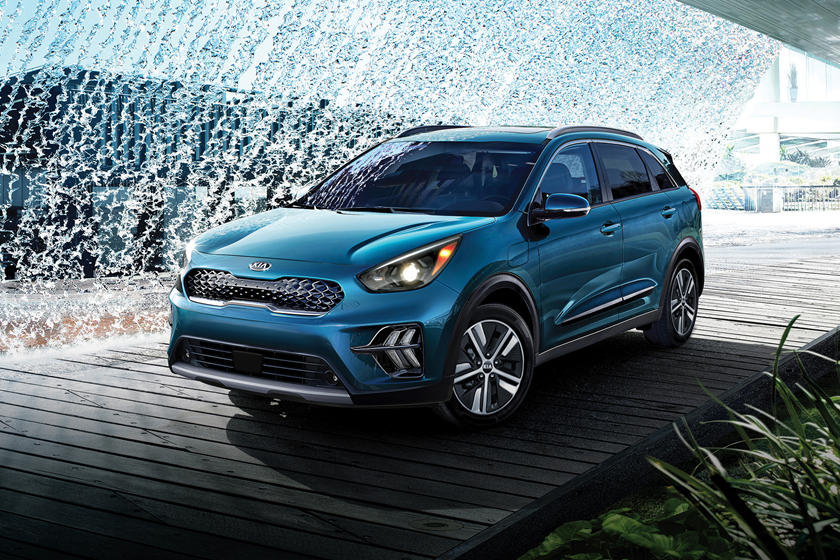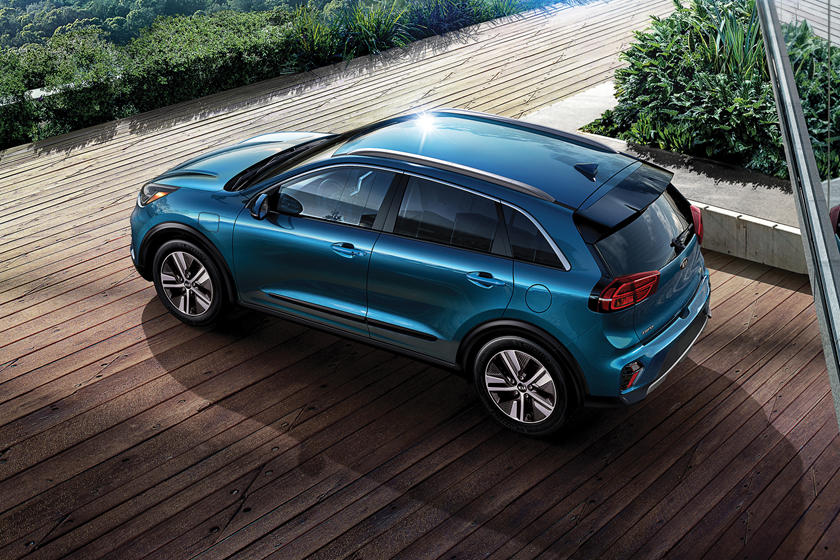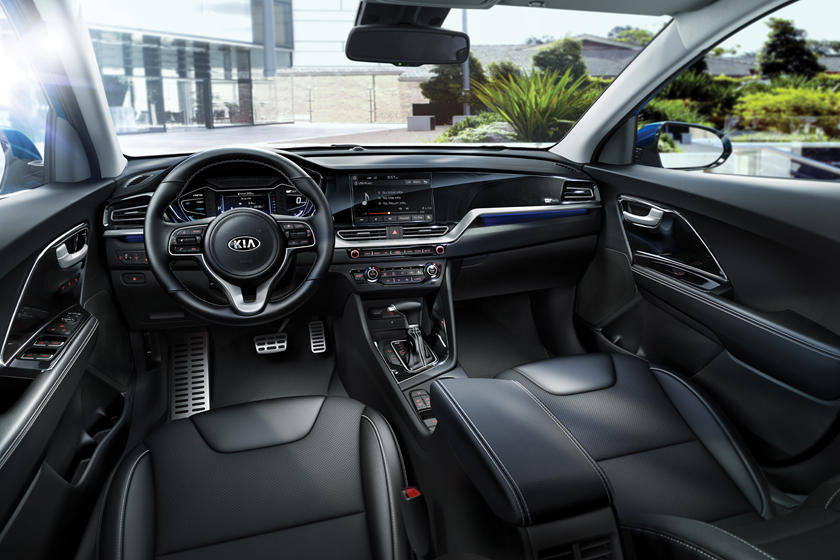The Kia Niro Plug-in Hybrid is an affordable and economical crossover that won't blow you away with its performance but promises high-value motoring. First introduced as part of Kia's foray into the hybrid market in 2018, the Niro Plug-in Hybrid remains a strong competitor to the likes of the Honda Clarity, Mitsubishi Outlander, and Subaru Crosstrek hybrids. Although it received a few more standard features for 2021, the Niro isn't changing at all this year. It is still powered by a four-cylinder engine paired with an electric motor to develop a combined 139 horsepower and 195 lb-ft of torque. Unlike many of its competitors, though, the Niro isn't offered with an all-wheel drivetrain, relying solely on front-wheel drive, instead. Still, Kia's offering is appealing to those who want to go green without breaking the bank.
In short, nothing. Kia is carrying over the 2021 model unchanged and the only way to tell which model year you're looking at is to observe the Kia logos inside and out. For the 2022 model, they have all been changed to Kia's new restyled corporate logo. And that's it.
See trim levels and configurations:
| Trim | Engine | Transmission | Drivetrain | Price (MSRP) |
|---|---|---|---|---|
| Plug-In Hybrid LXS |
1.6L Inline-4 Plug-in Hybrid
|
6-Speed Automatic
|
Front-Wheel Drive
|
$29,590 |
| Plug-In Hybrid EX |
1.6L Inline-4 Plug-in Hybrid
|
6-Speed Automatic
|
Front-Wheel Drive
|
$33,390 |
| Plug-In Hybrid EX Premium |
1.6L Inline-4 Plug-in Hybrid
|
6-Speed Automatic
|
Front-Wheel Drive
|
$36,490 |
While it is neatly styled, the Niro's exterior lacks the design flair of the new Kia EV6 and the butch appeal of conventionally-powered SUVs like the Sorento and Telluride. The latest diamond-pattern grille is eye-catching, but it's the redesigned headlights and foglights that really take the cake. Dual chevron-shaped LED daytime running lights also come standard, and the taillights have been modernized, too. The front and rear bumpers are body-color, but the wheel arches and side sills are lined in black plastic. The sleek curves of the side profile are accentuated by small wings positioned just above the side sills. LED projection headlights are equipped to the top trim in the range. Runway Red and Deep Cerulean are two of the more vibrant colors on offer. All this was par for the course last year and the only change to the Niro's appearance this year is the new Kia logos.
Falling within the compact crossover segment, the Niro PHEV isn't overly large, measuring only 171.5 inches long with a 106.3-inch wheelbase. The SUV stands 60.8 inches tall and can fit into pretty tight spaces with a width of 71.1 inches. It's no off-roader and this is confirmed by only 6.3 inches of ground clearance. The curb weight for all three trims is claimed to be 3,391 lbs.
Every model in the Kia Niro PHEV gets the same powertrain. The 1.6-liter four-cylinder engine develops 104 hp and 109 lb-ft on its own, but it comes paired with an electric motor that contributes an additional 60 hp and 125 lb-ft. Together, they deliver a combined 139 hp and 195 lb-ft to the front wheels. No all-wheel-drive drivetrain is offered, but where many rivals equip their hybrids with CVT transmissions, the Kia gets a sportier dual-clutch six-speed automatic gearbox.
Despite this, the Niro Plug-in doesn't really impress. Acceleration is particularly disappointing when you're expecting the kind of kick we've come to expect from high-torque electric vehicles. Sure, the SUV will get you around town without too much fuss, but highway maneuvers will require some planning. For what it's worth, Kia claims that the Niro PHEV will get to 62 mph in a tardy 10.8 seconds and reach a top speed of 107 mph. The Niro has no towing capacity rating so if it's a hard-working crossover you want, this isn't it.
Despite its slight dimensions and fairly torquey powertrain, the Kia Niro PHEV is not an athletic driver. Acceleration is uninspiring and relies too much on the gasoline engine than the electric motor. The compact SUV quickly loses its breath when pressed to go beyond the most sedate of cruising speeds. Keep to the speed limit, though, and the Niro is actually quite pleasant. It handles more like a hatchback than a crossover, with a little body roll and a firmer ride than you might expect. Nevertheless, steering is light and responsive, which is ideal for the hustle and bustle of town living.
Considering its slightly firm suspension and absolutely average interior, the Niro provides only adequate ride comfort. But, while it doesn't stand out in any way, the Kia doesn't actively disappoint, either. It's an unobjectionable SUV that will suit most driver's needs.
Fuel economy is certainly the crux of the matter when it comes to purchasing a hybrid vehicle. Knowing that you're alleviating some of the strain on the environment is nice, sure, but seeing the strain lifted from your own wallet is even nicer. In this regard, the Kia Niro PHEV makes an excellent case for itself. It doesn't get a particularly large tank, with only 11.4 gallons of fuel available but, thanks to its impressive mileage figure of 46 mpg in a mix of city/highway driving, the little SUV can cover an impressive 560 miles between visits to the gas station. The all-electric range is a little limited, though, with only 26 miles covered without gas. The overall hybrid combined mileage of the Kia Niro is 105 MPGe, which stacks up very well against rivals like the Mitsubishi Outlander PHEV, which only gets 74 MPGe.
Charging the battery from a standard household outlet (Level 1) takes around nine hours, while installing a Level 2 charger (240 V) drops this to two hours and 15 minutes.
While it offers seating for up to five within the cabin, the Niro PHEV isn't exceptionally roomy but there's enough space for average-sized adults to travel comfortably at the back when necessary. But, despite the lack of shoulder room, there is plenty of headroom in both rows of seats. Legroom is also excellent up front, but tall adults will feel the strain in the back. The tall roof makes getting in and out of the SUV quite easy, and it also improves side and rearward visibility when driving. The two upper trims offer a ten-way power driver's seat for an even better driving position, and the front seats come heated, too. The standard upholstery is cloth, while the EX gets a mix of cloth and leather upholstery. The top-tier EX Premium gets full SynTex leatherette upholstery.
While the standard cargo capacity of 19.4 cubic feet isn't overly impressive for a compact SUV, the Kia Niro hybrid plug-in compares quite well with other hybrid vehicles, which generally sacrifice some back-seat or trunk space to accommodate the hybrid components. As is common in most crossovers, the rear seats can be folded down to free up more space. In this case, the Niro PHEV is able to swallow up to 54.5 cubic feet of cargo. This can be increased to a pretty impressive 63.2 cubic with the standard under-floor cargo tray.
Small-item storage is also pretty average. There is a standard glove compartment, and the center armrest cubby is modestly sized. Each of the four doors presents passengers with a pocket, and there are cupholders in both rows of seats.
Considering its pretty affordable price tag, the Kia Niro PHEV SUV comes extremely well-equipped for the segment. Standard specs on even the base model include a 4.2-inch driver-information display, a leather-trimmed steering wheel and shift knob, dual-zone automatic climate control, cruise control, remote, start, and keyless entry and ignition. Kia Drive Wise also comes standard, with the suite on the entry-level LXS including blind-spot monitoring, rear cross-traffic alert, lane-keep and lane-following assist, driver-attention assist, a rearview camera, and forward-collision avoidance. The upper trim levels upgrade the standard features with adaptive cruise control, a seven-inch digital instrument cluster, heated front seats, and a ten-way power driver's seat. The safety suite also gets additional front sensors and adaptive cruise control. The top-tier EX Premium rounds out the standard offering with rear parking sensors, a heated steering wheel, and ventilation for the front seats. A power sunroof is also added on the top trim.
The infotainment suite was upgraded two years ago, with the base LXS trim coming equipped with a larger eight-inch touchscreen. Last year, wireless operation of Apple CarPlay and Android Auto became standard on the lower two trims. The standard suite supports AM/FM Radio, HD Radio, Bluetooth streaming, and SiriusXM. Six speakers make up the sound system on the entry-level trim and USB ports are available for charging or streaming media. The top trim level gets the larger 10.25-inch touchscreen, which comes programmed with voice-command navigation, but this system still uses wired Apple CarPlay/Android Auto. The sound system is also upgraded to an eight-speaker Harman Kardon set-up with an integrated subwoofer. Images displayed are crisp, and the interfaces easy to understand, while the Harman-Kardon system puts the default setup to shame.
While it hasn't received a quality and reliability rating from J.D. Power, the Kia Niro Plug-in has not been subject to any recalls. There were quite a few complaints logged in 2019, though, with most of these relating to the powertrain. If you do run into any issues, the Niro has an excellent warranty plan. The limited warranty is valid for 60,000 miles/five years inclusive of 24-hour roadside assistance, while the powertrain warranty runs for 10 years/100,000 miles.
The latest iteration of the Kia Niro Plug-in Hybrid hasn't undergone a review for safety by the NHTSA or IIHS. We don't expect the NHTSA to test the vehicle, as it never has in the past, but it did test the structurally similar normal hybrid. Its performance wasn't stellar, with four-star overall, frontal, and rollover ratings and the side crash garnering the only five-star rating. The IIHS did test the PHEV and gave the 2022 model top marks in every crashworthiness category following recent reviews. Standard advanced safety features across the range include forward collision assist, lane-keep and lane-follow assist, blind-spot detection, rear cross-traffic alert, a rearview camera with dynamic guidelines, and high-beam assist. Rear parking sensors, highway driving assist, smart cruise control (including navigation-based cruise control), and cyclist detection are all offered on upper trims. A total of seven airbags includes side curtain airbags and a knee airbag for the driver.
The Kia Niro PHEV is a bit of a mixed bag, getting as many things right as it does wrong. The powertrain is uninspiring, which, coupled with middling handling, doesn't make for a very engaging drive. The lack of available all-wheel drive is also disappointing on a modern crossover. Add to this the Niro's relatively low cargo capacity, and it feels more like a hatchback than an SUV.
But, much like a hatchback, the Niro PHEV delivers extraordinary fuel economy. When you take into account that it has a starting price of under $30k where most rivals start in the mid-30s, the Kia is certainly appealing to shoppers on a budget. It doesn't hurt that the car comes well-appointed for that price, with a modern infotainment suite and plenty of standard safety features.
There are certainly better options out there, if you don't mind paying a bit extra upfront and in the long run, but the Kia Niro PHEV is a solid offering in a market already saturated with average vehicles.
The Niro PHEV range hasn't undergone changes for the USA and the prices of the respective trims haven't changed much either. The entry-level model is the LXS, with a starting MSRP of $29,590, the same as last year. The EX and EX Premium cost $33,390 and $36,490, respectively, the latter actually $60 cheaper this year. These prices do not include tax, registration, licensing, or Kia's destination charge of $1,175. It is worth noting that the hybrid does qualify for federal tax credits or other rebates in some US states. You'll need to check your state's specific terms and conditions regarding this. What does apply is a federal tax credit of $4,543.
The Kia Niro is extremely well-priced, so it won't actually hurt you much to splurge a little on one of the more well-appointed configurations. The power-adjustable driver's seat, heated front seats, and wireless charger that come standard on the mid-tier EX are quite appealing, as is the added forward-collision avoidance, smart cruise control with stop and go, and rear-occupant alert. But whether or not that is worth the extra $4k is up to you. Even the entry-level LXS has a lot to offer for how much it costs, with the same infotainment suite as the EX and more than enough standard safety features like blind-spot monitoring and forward-collision assist. The upgraded infotainment suite on the EX Premium may tempt some buyers, but at that price tag, you could pick up one of the Kia Niro's better-value rivals.
| Competitor | Horsepower | MPG | Price (MSRP) |
|---|---|---|---|
| Kia Niro Plug-In Hybrid | 139 hp | TBC | $29,590 |
| Mitsubishi Outlander Plug-In Hybrid | 126 hp | TBC | $36,995 |
| Subaru Crosstrek Hybrid | 148 hp | TBC | $36,345 |
Quite a bit bigger than the Kia Niro by comparison, the Mitsubishi Outlander PHEV also boasts an extra inch of ground clearance. Paired with the available all-wheel-drive system, this gives the Outlander some genuine off-roading capabilities. This is a nice feature on a crossover when many rivals only look capable but fail to deliver when asked to. The Mitsubishi also has quite a few extra ponies under the hood, with over 200 hp developed by its combination hybrid engine. The extra overall size does give the Outlander some advantages in terms of passenger and cargo space, offering 30.4 cubic feet behind the rear seats. But, considering the pretty hefty starting price of $36,995, the Outlander certainly doesn't offer the same level of high-tech features as the Niro's similarly priced upper trims. If you don't intend to go off-road, and the smaller 19.4-cubic-foot trunk doesn't bother you, the Kia Niro is the smarter buy here, and it runs a lot cheaper, too.
Much like the Mitsubishi Outlander, the Subaru Crosstrek Hybrid is a bit bigger than the compact Niro, and it gets more ground clearance, too. Once again, this means the Kia's competition has some legitimate off-roading capabilities. However, with only 148 hp on tap, the Crosstrek isn't much stronger than the Niro PHEV, although it does offer an all-wheel-drive system. Subaru has equipped its SUV with more standard features, but these will cost you quite a bit extra, with the Crosstrek Hybrid starting at $35,345 compared to the Niro's $29,590. The Kia Niro gets considerably better fuel economy, too, so unless you plan on going off the beaten path, the Subaru Crosstrek isn't quite as appealing.
The most popular competitors of 2022 Kia Niro Plug-In Hybrid:






